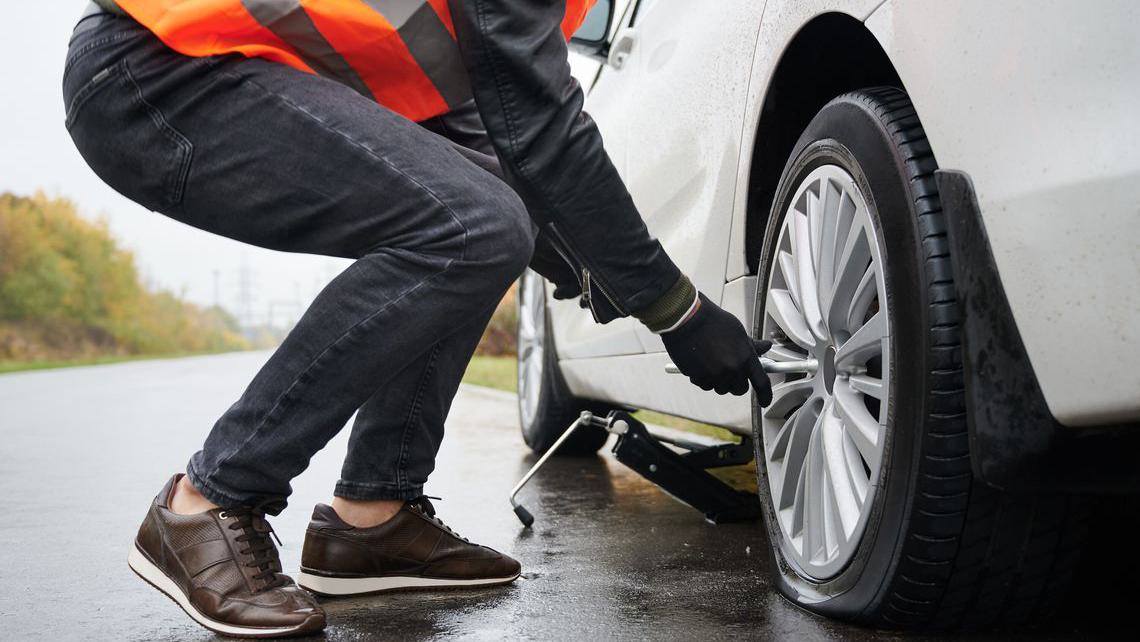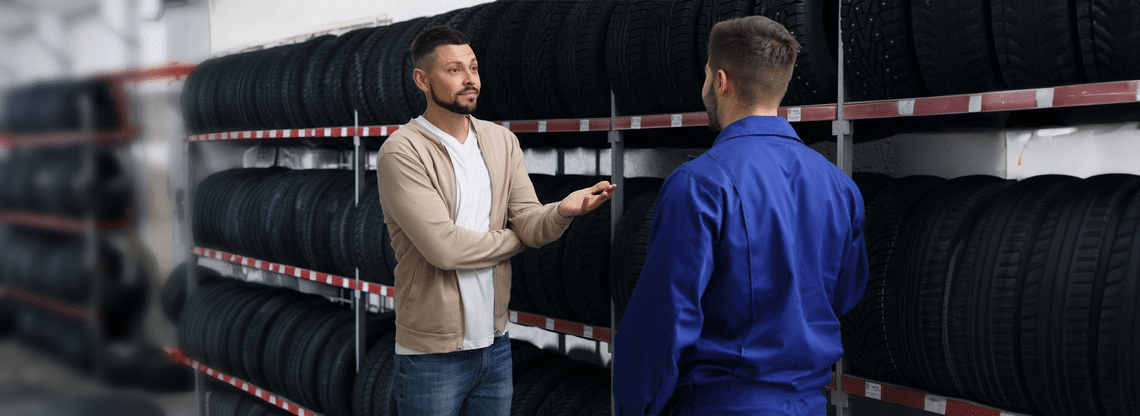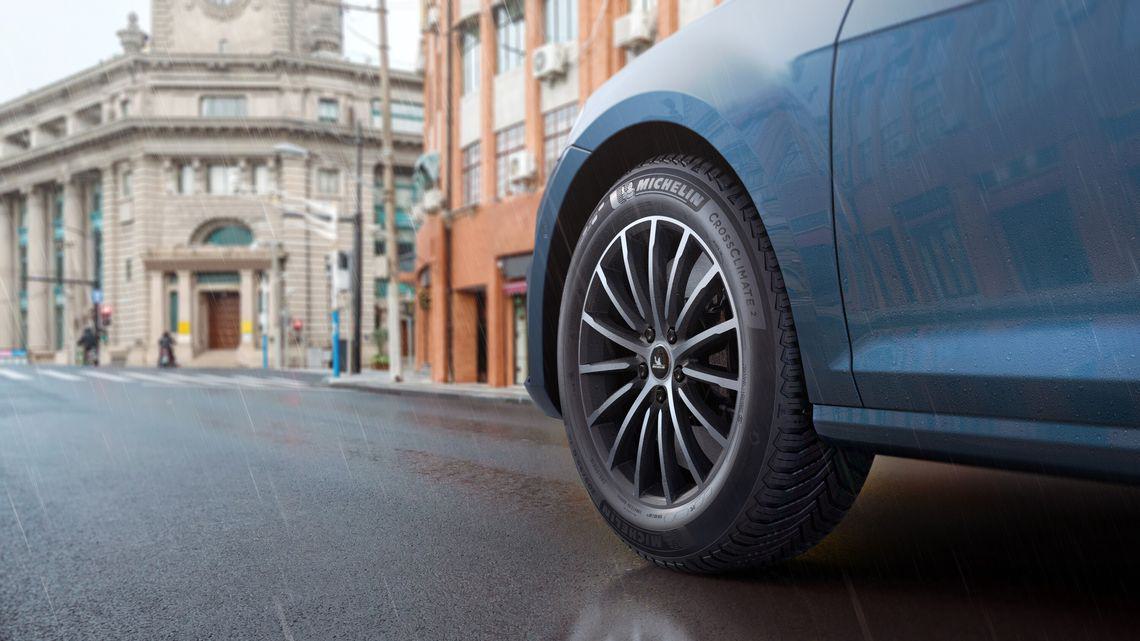Fitting tyres to your car

How to change a tyre
Step 1: Removing the tyres
Once at the garage, the technician can get started with fitting the tyres. To begin, they’ll raise the car using a hydraulic lift, so all four of the wheels are off the ground.
Step 2: Taking off the wheel nuts
Now it’s time to unscrew the wheel nuts or lug nuts. These can be found just below the hub cap. These are normally round or hexagonal, and can be loosened by applying pressure and pushing counter clockwise.
Step 3: Swapping out the tyres
After releasing inflation pressure by unscrewing and removing the valve insert, the old tyre or tyres can be taken off the wheel rim. The technician will likely use a professional tool called a tyre spreader for this, which helps them do it without causing any damage to the wheel or other fittings.
Step 4: Fitting new tyres
Now that the old tyres are off, the technician will need to check the state of the rim and inspect whether rust and/or wear and tear are damaging it. Once the controls are made, a new tyre, with width fitting the size of the wheel rim, will be installed. The car can be fitted with tubeless or tube type tyres. The construction of both is very similar, the main difference is that tubeless tyres do not have the inner tube to hold the pressurised air. Instead, the rim and tyre both form an air container to hold air.
Once your choice between tubeless and tube type tyres is made (tubeless tyres are the most common), before fitting the new wheel, the professional will check that the tread patterns are facing in the right direction before using the tyre spreader to fit them onto the wheel. Using a long extension hose for safety, the tyre or tyres will then be inflated to the correct air pressure.

Step 5: Final checks
The technician will check the old tyres for any signs of uneven wear in the tread pattern, as poor wheel alignment or out-of-balance wheels can be the cause of premature tread wear. If so, the technician can alter the axle geometry of the car so it’s in the correct position or correct wheel balance to ensure the correct weight is distributed evenly.
Step 6: Lowering down
Before fitting the new tyres and wheel rims on the car, the mechanic will make sure the new tyres are correctly mounted. If you have directional tyres, they need to be placed in the right direction to ensure they are delivering their full performance. When correctly mounted, the arrow marked on the sidewall of the tire should be positioned in the direction of rotation.
Once the tyre is fitted on the car, the wheel nuts will be tightened most of the way by hand, before the car is lowered back down to the ground and the nuts tightened fully using a professional tool, called a torque wrench. After that, you’re good to go and get back on the roads!
Frequently asked questions:
What is the cost of fitting tyres?
The price of fitting new tyres will vary depending on your location, tire size and requirements, such as if you’re having multiple tyres fitted or just a single one following a flat tyre. It may also vary depending if you buy your tyres at the retailer and have them fitted there, or purchase them separately.
How long does it take to change a tyre yourself?
From bumpy potholes to driving over a nail, getting stuck with a flat tyre is an unfortunately common occurrence that all drivers experience at some point. Although it’s best to get a professional to change your tyres, if you’re stuck it is possible to put on a spare one yourself or use a car tyre sealant spray before driving to a garage to get your tyre check out or replaced.
Depending on how confident you are, a punctured tyre can be changed for a spare tyre in less than 30 minutes, but make sure to take your time, and proceed safely through each step. Remember that you must only work on your vehicle in a safe, permitted location and that the vehicle and the jack must be on stable ground, the wheels chocked, the parking brake on, and in gear (or Park for an automatic), so that it cannot roll. Also, your spare wheel must be at the correct pressure, it is important to check the pressure of the spare tire regularly at every safety check with a professional. If you’re concerned, it can be a good idea to practice changing a tire in a secure location, such as when parked at home.
Before you drive anywhere, you should always make sure you have all the things you’ll need to change a spare tyre just in case. Most of these should come with your vehicle, but others are useful extras to have stored in your car trunk for a wide range of potential emergency situations, such as a flashlight or car puncture repair kit.
How far can you drive on a spare tire?
Depending on the type of spare tyre you have, they’re usually not designed to be used for a long time – or at particularly high speeds. Some car models only have space for smaller spare tyres, which shouldn’t be driven over 80 Kph as they have less traction and are less able to handle the road in poor weather. Keep in mind that your spare could also be a different season tyre from the other ones on your car.
Once the spare is fitted, visit a tyre specialist as soon as possible to make sure that the wheel is secure and for an inspection of your damaged tyre. If the spare is a Temporary Use or Space Saver spare, you must comply with the restrictions on use as described in your vehicle handbook. But as a rule, check in with your garage as soon as you’re able to for a full assessment and to replace your flat tyre with a new one.
When should car tyres be replaced?
It is strongly advised to replace your tyres after 10 years. However, if you notice that you tyre is damaged or has reached the legal tread wear limit before this period, it must be replaced. As a general rule of thumb, you should get your tyres checked by a professional every 5-6 years.




